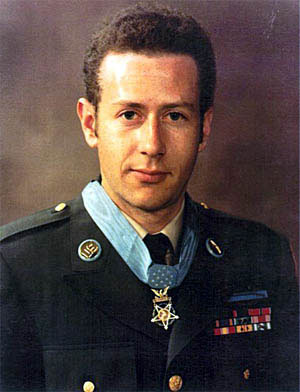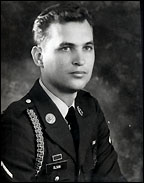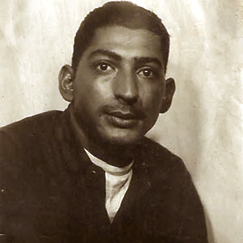
Captain Eurípides Rubio was a United States Army officer and one of nine Puerto Ricans who were posthumously awarded the United States' highest military decoration for valor, the Medal of Honor, for actions on November 8, 1966, during the Vietnam War. Rubio was a member of the United States Army, Headquarters & Headquarters Company, 1st Battalion, 28th Infantry Regiment, 1st Infantry Division, Republic of Vietnam.

The Battle of Ia Drang was the first major battle between the United States Army and the People's Army of Vietnam (PAVN), as part of the Pleiku Campaign conducted early in the Vietnam War, at the eastern foot of the Chu Pong Massif in the central highlands of Vietnam, in 1965. It is notable for being the first large scale helicopter air assault and also the first use of Boeing B-52 Stratofortress strategic bombers in a tactical support role. Ia Drang set the blueprint for the Vietnam War with the Americans relying on air mobility, artillery fire and close air support, while the PAVN neutralized that firepower by quickly engaging American forces at very close range.

Wesley Lee Fox was a highly decorated United States Marine Corps colonel with 43 years of service. Fox was a combat veteran – receiving the Medal of Honor for his heroic actions during the Vietnam War – and is considered one of the Marine Corps' legendary heroes. After retiring from the Marine Corps, he wrote a book about his career: Marine Rifleman: Forty-Three Years in the Corps; and, he served for 8 years as deputy commandant for the Virginia Tech Corps of Cadets.

Gordon Ray Roberts is a retired United States Army officer and a Medal of Honor recipient for his "conspicuous gallantry and intrepidity in action at the risk of his life above and beyond the call of duty" on 11 July 1969 while an infantryman with the 1st Battalion, 506th Infantry, 101st Airborne Division during the Vietnam War.

Alfredo Cantu "Freddy" Gonzalez was a United States Marine Corps Sergeant who posthumously received the Medal of Honor for service in the Battle of Huế during the Vietnam War.

Raymond G. Harvey was a lieutenant colonel in the United States Army who served during World War II and the Korean War. He received the Medal of Honor for his actions on March 9, 1951.
Mack Alvin Jordan was a soldier in the United States Army during the Korean War. He posthumously received the Medal of Honor for his actions on November 15, 1951.

William Franklin Lyell was a soldier in the United States Army during the Korean War. He posthumously received the Medal of Honor for his actions on August 31, 1951.

Jerome Aubrey Sudut was a soldier in the United States Army during the Korean War. He posthumously received the Medal of Honor for his actions on September 12, 1951, during the Battle of Heartbreak Ridge.

Puerto Ricans have served as members of the United States Armed Forces and have fought in every major conflict in which the United States has been involved from World War I onward. Many Puerto Ricans, including those of Puerto Rican descent, have distinguished themselves during combat as members of the five branches of the U.S. Military, the Army, Marines, Navy, Air Force and the Coast Guard.

Robert Franklin Foley is a retired United States Army lieutenant general who served in the Vietnam War. He received the Medal of Honor for leading his unit in an assault on a strong enemy position on November 5, 1966 during Operation Attleboro.

Kenneth Edward Stumpf was a United States Army soldier and a recipient of the United States military's highest decoration, the Medal of Honor, for his actions in the Vietnam War.

James Michael "Mike" Sprayberry is a former United States Army officer and a recipient of the United States military's highest decoration, the Medal of Honor, for his actions in the Vietnam War.

Richard Allen Penry was a United States Army soldier and a recipient of the United States military's highest decoration—the Medal of Honor—for his actions in the Vietnam War.

Kenneth Lee Olson was a United States Army soldier and a posthumous recipient of the United States military's highest decoration, the Medal of Honor. He received the award for sacrificing his own life during the Vietnam War by throwing himself over an activated hand grenade, saving the lives of fellow soldiers around him.

Joseph Xavier Grant was a United States Army officer and a recipient of the United States military's highest decoration—the Medal of Honor—for his actions in the Vietnam War.

George Peterson was a United States Army soldier and a recipient of the United States military's highest decoration—the Medal of Honor—for his actions in World War II.

Leonard Louis Alvarado was a U.S. Army posthumous recipient of the Medal of Honor during the Vietnam War.

Félix Modesto Conde Falcón was a United States Army soldier and a recipient of the Medal of Honor. Born in Juncos, Puerto Rico, he joined the United States Army in April 1963 in Chicago, Illinois. He was killed during combat operations in Ap Tan Hoa, South Vietnam, on April 4, 1969. He was posthumously awarded the Medal of Honor by President Barack Obama in a March 18, 2014 ceremony in the White House. The award comes through the Defense Authorization Act which called for a review of Jewish American and Hispanic American veterans from World War II, the Korean War and the Vietnam War to ensure that no prejudice was shown to those deserving the Medal of Honor.

















